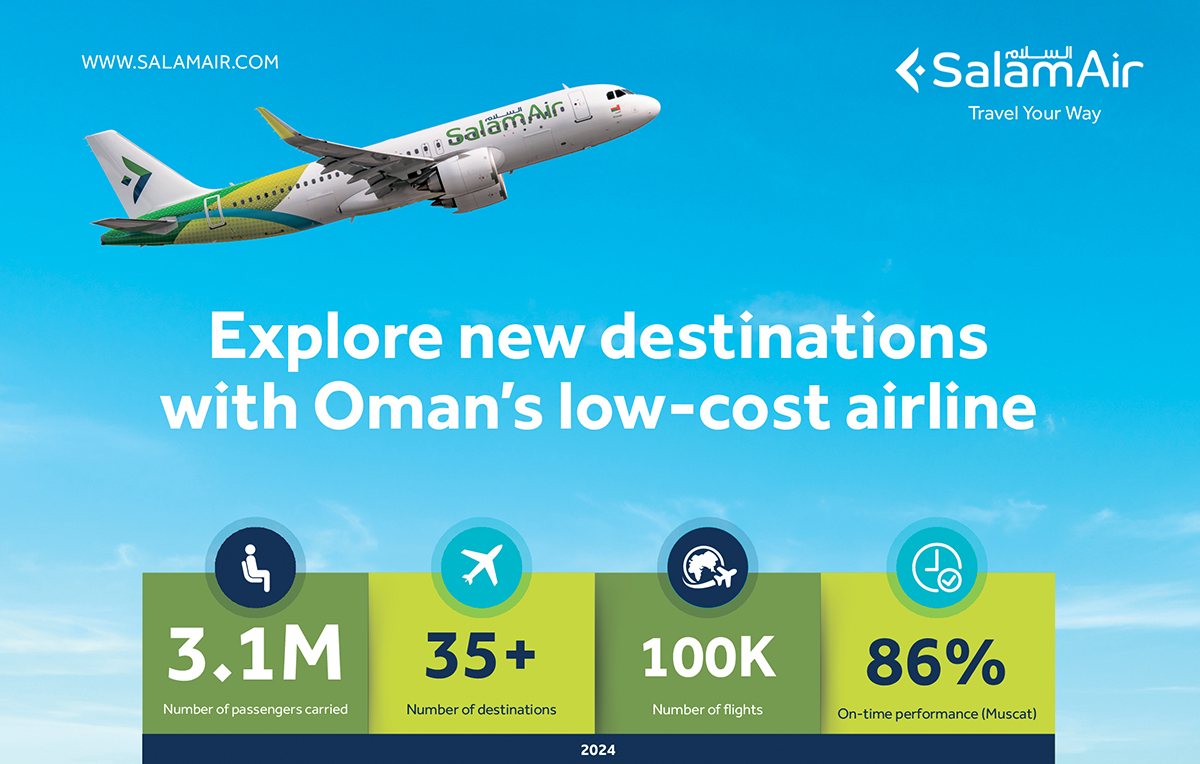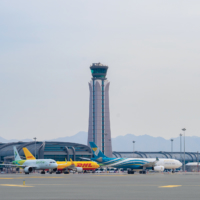With Oman’s Vision 2040 aiming to position the sultanate as a global logistics and tourism hub, SalamAir is playing a crucial role in helping the country to achieve these ambitions by enhancing regional and international connectivity.
The low-cost carrier has rapidly expanded its network since its inception in 2016, linking Oman with key destinations across the Middle East, Asia and Africa. Now, plans are underway to not only introduce new routes, but also to significantly expand its fleet in the coming years.
“Low-cost airlines drive volume tourism, and our high-density aircraft reflect this,” said Adrian Hamilton-Manns, CEO of SalamAir. “We are also growing rapidly, with 13 aircraft in service and two more arriving from Sumitomo Mitsui Banking Corp. in June and July this year, bringing our fleet to 15.

“Recently, we issued a request for proposals to add 10 more aircraft over the next three years. Expanding our fleet is essential to achieving Oman’s Vision 2040 and by 2028, we aim to grow passenger numbers from 3.2 million to 8 million, nearly tripling our current capacity.”
Explaining how the airline assesses the potential of new destinations, Hamilton-Manns said: “We are expanding strategically, focusing on underserved routes. We have recently launched a flight to Nairobi, adding to our East Africa network, which will include many untapped destinations such as Hargeisa, Port Sudan, Mogadishu and Mombasa.
“In South Asia, we already serve 17 destinations in India, Pakistan, Thailand, Sri Lanka and Bangladesh. We are also targeting Eastern Europe, Central Asia and China. Our low-fare model is designed for emerging markets, so anything within a six-hour range is under consideration,” he said, naming cities like Budapest, Prague, Almaty, Astana, Tashent and Chengdu.
“Our goal is to boost Oman’s tourism, driving infrastructure and investment demand.”
Despite operating for less than a decade, SalamAir has already established itself as a major player in Oman’s aviation industry, proving that there is strong demand for low-cost travel throughout the region. Due to this, Hamilton-Manns is confident that the airline will be able to grow in the years ahead and will be able to help Oman meet its tourism goals.
“We believe in low fares and high passenger volume. It’s been proven worldwide, and Oman is no different,” he said. “Fares can drop further, but passenger numbers drive this. Vision 2040 in Oman places tourism at the heart of gross domestic product growth, similar to New Zealand, where tourism is 4% to 5% of GDP and the sector employs over 200,000 people.
“Our focus is on adding more planes, connecting Oman to the world, and helping to grow the economy.”
Another way in which SalamAir is actively supporting Oman’s tourism sector is by highlighting the varied appeal of the destination. This has seen the airline actively promote destinations such as Salalah, which is home to frankincense souqs, historic sites and scenic areas with views of humpback and blue whales.
Dhofar, in the southern region of Oman, is particularly popular with travelers during the monsoon season. Typically running from June to September, the cooler temperatures and misty rainfall transform the region into a verdant oasis.
“In recent years, we have actively promoted Salalah as a top tourist destination during the monsoon season. To support this, we’ve operated nonstop seasonal flights to GCC (Gulf Cooperation Council) countries, including Kuwait, Bahrain and the United Arab Emirates, as well as international cities like Prague,” Hamilton-Manns said.
“Recently, we have taken our efforts further by partnering with Salalah’s leading hotel owner, marking our first collaboration of this kind.
“With 8 million passengers expected in three years, aligning with tourism demand is crucial. We are engaging with the Ministry of Heritage and Tourism to strengthen our role in driving tourism growth. We are privileged to be part of Oman’s future and are committed to being a responsible corporate citizen.”
Part of this responsibility is matching Oman’s sustainability goals. This has led to SalamAir implementing new initiatives to minimize its environmental impact. “Our entire fleet consists of modern A320 NEOs, the lowest-emission aircraft available,”Hamilton-Manns said.
“With high-density seating — 180 seats on the A320 and 230 on the A321 — our per-passenger emissions are up to 60% lower than other regional airlines. We are also working with Civil Aviation to finalize a trading scheme, making all our flights effectively carbon-neutral.
“Since last year, we’ve also matched the Carbon Offsetting and Reduction Scheme for International Aviation payments with passengers, ensuring full compliance
“Beyond carbon reduction, we also use software to manage contrail formation, minimizing our environmental impact.”
https://info.japantimes.co.jp/international-reports/pdf/20250625B-GI_Oman.pdf
https://global-insight.net/







